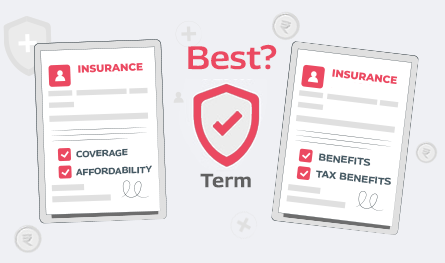Expert Advice on Term Insurance: Is It Right for You?

Just because you need a laptop, do you just enter the nearest shop and purchase the first one? Definitely not. You would do some research online, check customer feedback, ask your peers and family members and then decide on a particular laptop brand and product. Imagine the list of criteria you will have to choose the right one. For the purchase of term insurance, too, you should have some checklists to ensure your loved ones are safe in your absence.

Tips to Choose the Term Policy
Are you labelled as a spendthrift? Do your family worry about how to make ends meet in your absence? If yes, then your best resort is a Term plan. Anyone who wants to meet their long-term objectives by financial planning should consider a term plan as a part of their portfolio. If you are yet to be convinced about this, these essential points are sure to convince you :
1. Concept of Human Life Value:
The first step in choosing a term plan is assessing your age, dependents, and financial situation. If you are the sole breadwinner, your financial responsibilities would extend to all family members who are dependent on you. A simple way to estimate coverage is to calculate your Human Life Value (HLV), which is an accumulation of your income or salary and liabilities like loans, etc. The right plan should provide at least the HLV amount as the coverage. The maximum life cover that can be provided is 20-25 times the annual gross salary income. But you also need to check for the annual expenses of your family as a whole to determine the final coverage.
2. Premium Payment Term:
The premium payment options vary with your income generation scenario and the dependents in your family. To understand this better, have a look at the given table below :
| Scenario (Income and Dependents) | The Best Term Plan |
| Sole Earner | A basic, increasing return on a premium term plan or a term plan with a whole-life option is the best. |
| Salaried with dependent family like parents, spouse and children | Term Plans with a regular premium payment term and efficient claim facilities |
| Self-employed or business owner with family dependency | Term plan with single premium payment option as income is erratic. |
| With existing liabilities like home loans and education loans to pay off. | Basic term plan coverage that can be used to pay off debts in case of untimely death |
| Having a pre-existing condition but being a contributor or the sole earner in the family | A basic term plan with the added benefit of critical illness rider. |
| Retired with dependents | A basic term plan for the financial security of dependents |
Besides these, the payment tenure should also be considered, whether you want to pay regular premiums for the entire policy duration, till your retirement or for the next 10 years. The early prepayment options for 5 years or 10 years are more lucrative, considering that regular income stops post-retirement. It is advisable though, to calculate the present value of future payments under different situations and then to take a financially viable decision.
3. Enhanced coverage with Additional Riders:
A lucrative feature offered by some providers in the market is the option to enhance your life coverage at critical junctures of your life, like marriage and becoming a parent. You have the flexibility to increase your coverage by 25% or even 50%. So you can start with a modest coverage and then increase it when the time is right.
In addition, riders can be added to the base policy to make your term plan a comprehensive one. Riders are tools to enhance your policy as they provide coverage under certain conditions, even when the policyholder is alive in some cases :
- Premium Waiver: If you face permanent disability, the insurance coverage continues without paying the future premiums.
- Accidental Death Benefit Rider: With this rider, you get the benefit of an enhanced sum assured. In case there is death due to an accident, the family members are entitled to accidental death cover, which is equal to the actual sum assured.
- Benefits of Monthly Income: If you feel, a regular income will help your family to manage finances better, then some insurance providers also pay out the sum assured monthly and not as a lump sum.
Besides these, there are riders for disability, loss of employmen,t etc., as well that can be of substantial assistance to you and your loved ones.
Moreover, a type of term plan, such as an endowment policy, also ensures a return on investment along with life coverage. Though more expensive than basic term plans, this type of policy can offer you the best of both worlds.
4. Premium Cost and Lifestyle Considerations:
After evaluating other parameters of the decision, you can look at the cost of the premium. However, the benefits and coverage should not be compromised. In case you feel the premium cost is becoming a burden, you can opt for quarterly or monthly payment frequency for convenience. Moreover, you should consider your life routines and habits before deciding on term plans. For instance, if your daily work involves engaging in life-threatening activities like construction, mining, fire fighting etc., you may require a higher sum assured to mitigate this high-risk potential. Also, with pre-existing diseases, you should explore term policies with add-on riders.
5. Credibility of Insurance Provider:
The claim settlement ratio and solvency ratio are the two strong indicators of the stability and credibility of the insurance-providing company. Claim ratio indicates the percentage of claims settled against the total claims filed in a year. The higher this ratio, the better the possibility of your family receiving the claim at the right time. Along with the ratio, it is also important to check the total number of claims. This ratio gains significance only if the number of claims settled is substantial. The solvency ratio becomes vital at the time of natural disaster when any insurer is required to settle huge volumes of claims together at the same time. This ratio shows whether your provider is financially capable of settling your claim at the time of your need. The Insurance Regulatory and Development Authority of India (IRDAI) requires every life insurance provider to have a solvency ratio of 1.5. Both these ensure that your family’s future is financially secured.

Author Bio
Paybima Team
Paybima is an Indian insurance aggregator on a mission to make insurance simple for people. Paybima is the Digital arm of the already established and trusted Mahindra Insurance Brokers Ltd., a reputed name in the insurance broking industry with 21 years of experience. Paybima promises you the easy-to-access online platform to buy insurance policies, and also extend their unrelented assistance with all your policy related queries and services.
Other Life Insurance Products
Latest Post
.png)
Accidents can happen anywhere, anytime, by your own fault or another person. What’s important is to be prepared for such mishaps. This is where Own Damage Car Insurance comes in handy.

.png)
The no claim bonus (NCB) in bike insurance is a very handy benefit that allows you to save money on your overall motor insurance costs. The bike insurance provider rewards you for not making a claim by offering a discount on the premium of the following year.

.png)
When it comes to medical emergencies, the last thing you want to worry about is arranging money for hospital bills. That’s where a health insurance claim comes in handy. Health insurance allows you to either get your expenses reimbursed later or, in many cases, get treated without paying upfront through a cashless facility.

.png)
Health insurance plans often come with terms that sound like they belong in a secret financial club. One such term is “co-pay.” You might have seen it in your policy document and quietly ignored it, hoping it won’t matter until you actually need to claim. But here’s the twist: co-pay can directly affect how much premium you pay each year.




